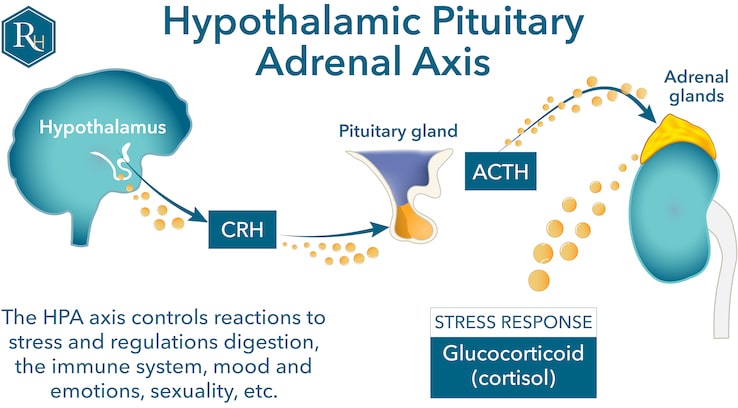Adrenal Fatigue or HPA Axis Dysfunction?

In 1998, Dr. James L. Wilson, DC, ND, Ph.D., coined the term “adrenal fatigue” and used it to describe a condition in which the adrenal glands — overstimulated by chronic stress, burn out and shut down — can promote one or more of the following symptoms:
- Abdominal pain
- Chronic fatigue
- Depression
- Diarrhea
- Excessive sweating
- Headache
- Hypoglycemia (low blood sugar)
- Irregular periods in women
- Irritability
- Loss of appetite
- Low blood pressure
- Muscle weakness
- Nausea
- Salt cravings
- Weight loss
In the 24 years since the concept was introduced, many books have been published and numerous nutritional supplements have been marketed to support adrenal gland health and function. Unfortunately, many people who followed the advice in these books or took these supplements experienced little to no relief.
As a result, the diagnosis of “adrenal fatigue” has been dismissed in some medicine circles and fallen out of use in others.
However, dismissing that diagnosis has led many doctors to “throw out the baby with the bathwater.” By ignoring the adrenal glands altogether, these doctors are returning to using medically accepted (albeit less descriptive and less helpful) diagnoses, such as fibromyalgia and chronic fatigue syndrome, to describe this cluster of symptoms.
In fact, many patients receive these diagnoses based solely on the process of elimination. Unable to identify the root cause of a patient’s illness, the doctor simply diagnoses it as chronic fatigue syndrome or fibromyalgia and attempts to provide some relief for the patient’s symptoms.
What’s really going on with patients who experience these symptoms does involve the adrenal glands but is more complex than originally thought. It actually involves the interaction of the hypothalamus and the pituitary and adrenal (HPA) glands — collectively referred to as the HPA axis.
Understanding HPA Axis Dysfunction
HPA axis dysfunction is a more accurate diagnosis than adrenal fatigue because it recognizes that the adrenal gland does not operate in a vacuum; problems upstream of the adrenal gland can and often do impact adrenal function. “HPA” refers to the three components involved in adrenal hormone production:
- Hypothalamus: The region of the brain that enables the body to maintain homeostasis (equilibrium) by regulating body temperature sleep, , , hunger, thirst, emotions, and so on.
- Pituitary gland: A tiny gland located at the base of the brain that regulates other endocrine glands, including the adrenal.
- Adrenal glands: Small glands located atop each kidney, that produce key hormones, including aldosterone, cortisol, androgenic steroids (DHEA, testosterone), epinephrine (adrenaline), and norepinephrine (noradrenaline).
Working in concert with one another, these three components regulate energy levels, mood, stress response, motivation, metabolism, , and the immune system. In response to stress, the hypothalamus secretes corticotropin-releasing hormone (CRH), instructing the pituitary gland to release adrenocorticotropic hormone (ACTH). ATCH instructs the adrenal glands to secrete glucocorticoids, including cortisol.
HPA axis dysfunction occurs when one or more of the three components of the HPA axis is not doing what it should be doing. For example, if the pituitary gland receives instructions to release ACTH and fails to do so, the adrenal gland won’t secrete glucocorticoids. The problem then is not with the adrenal gland but with the pituitary gland.
Undiagnosed or Misdiagnosed
People who suffer from HPA axis dysfunction are often undiagnosed or misdiagnosed. As a result, they and their doctors engage in a process often described as “chasing symptoms.” They focus on relieving whatever symptoms are most prevalent at any given time. As a result, patients are often prescribed antacids to treat their indigestion, antidepressants to alleviate low mood or energy, or steroid shots to reduce inflammation. The root cause of their condition is never addressed, and the medications they take often create other health problems.
Identifying the Root Causes of HPA Axis Dysfunction
Usually, the HPA axis dysfunction is a product of inflammation, which is typically triggered by chronic stress — both physical and emotional. Sources of stress typically include one or more of the following:
- Dysfunctional relationships or situation at home
- Unhealthy environment at work or school
- Bacterial, viral, or fungal infections, which may not have been diagnosed or are not fully responding to treatment
- Environmental mold and other toxins
- Nutritional deficiencies
- Food sensitivities
- Gut dysbiosis (an imbalance of microorganisms in the digestive tract)
Inflammation causes dysregulation of the signals in the brain coming from the hypothalamus, causing a chain reaction that impacts the pituitary gland and ultimately the adrenal glands. HPA axis dysfunction can impact the entire body causing numerous symptoms that are difficult to trace to any single illness or dysfunction.
Treating HPA Axis Dysfunction
Here at Restoration Healthcare, treatment for hypothalamus and pituitary and adrenal gland dysfunction typically involves identifying and reducing the impact of stressors, treating any underlying infections, reducing exposure to environmental toxins, detoxing the body, and adjusting the diet to eliminate any problem foods. Repairing any damage to the lining of the gut and restoring populations of beneficial microorganisms that inhabit the gut may also be necessary.
Taking the First Step to Recovery
The first step to recovery is to obtain an accurate diagnosis from a healthcare professional who understands hypothalamus and the pituitary and adrenal (HPA) glands axis dysfunction. If you or someone you know is experiencing any of the symptoms described in this post, we strongly recommend that you schedule an appointment with a functional and integrative healthcare provider for an examination and testing. With an accurate diagnosis in hand, you can begin to treat the root cause(s) of whatever is ailing you and get back on the path to health and fitness.
Adrenal-related illnesses, like many medical ailments, exist on a spectrum and often involve more than one gland or organ or system. They are complicated conditions that require careful examination and detailed testing to unravel the mystery, and they often involve several interrelated dysfunctions. Adrenal illnesses cannot be treated effectively simply by taking medications that suppress symptoms or supplements claiming to support adrenal health and function.
– – – – – – – – – – –
Disclaimer: The information in this blog post about hypothalamus and the pituitary and adrenal gland dysfunction is provided for general informational purposes only and may not reflect current medical thinking or practices. No information contained in this post should be construed as medical advice from the medical staff at Restoration Healthcare, Inc., nor is this post intended to be a substitute for medical counsel on any subject matter. No reader of this post should act or refrain from acting on the basis of any information included in, or accessible through, this post without seeking the appropriate medical advice on the particular facts and circumstances at issue from a licensed medical professional in the recipient’s state, country or other appropriate licensing jurisdiction.


